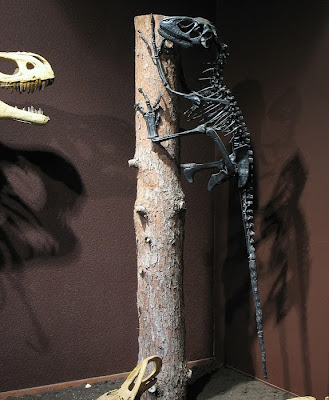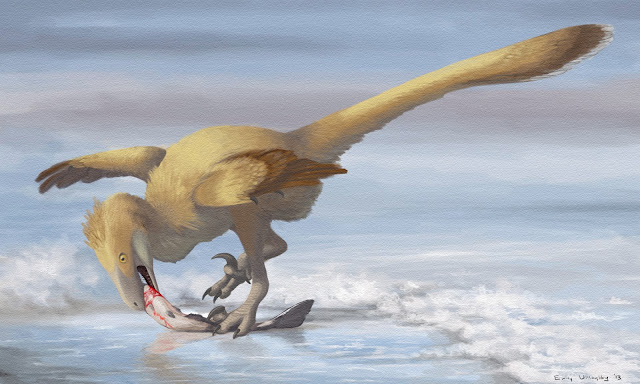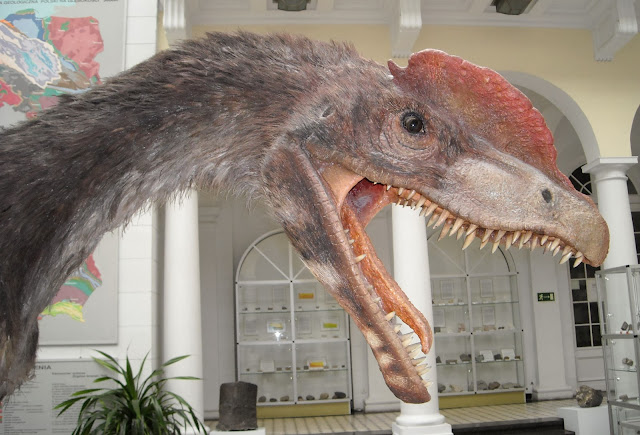 |
| ©Nobu Tamura |
↧
First Step Backwards
↧
Climbing and Slashing
 |
| Artist Unknown |
 |
| ©John Sibbick |
 |
| Photo by Davide Meloni |
↧
↧
Dromaeosaurs for Kids
Deinonychus has many sites that relate information at lower, middle, and higher reading levels; one of the many perks of being a more popular dinosaur I suppose. KidsDinos hits the lowest level readers with concise and pretty accurate facts while the middle level readers in your house can fairly easily read Kids Dig Dinos, though be aware that some of the facts presented are a little incorrect or exaggerated. The highest level kid related page we have today is New Zealand based Science Kids, but it is a short read also. Just to wind up today. There is a Dinosaur Train episode featuring Derek the Deinonychus and there is also a wealth of coloring pages.
↧
Movie Star Here
Slightly larger than they should be, and under the misnomer of Velociraptor, dinosaurs based on Deinonychus but the size of Utahraptor pepper all of the Jurassic Park movies. Understanding the idea of Michael Crichton and being quite happy with the fact that he used a synonymic name that was, by the time of the movie's release, outdated and overturned, I am quite okay saying that Crichton's "raptors" were as accurate as he intended them to be in his book. Bearing that in mind, look at the "raptors" of Jurassic park in the way they were intended to be portrayed:
Also, one of my favorite quotes from the book:
“Hammond whined. ‘But what are you going to do to my animals?
‘That’s not really the question, Mr. Hammond,’ Muldoon said. ‘The question is, what are they going to do to us?’” (p. 303).
Also, for a slightly more updated look, check out how Deinonychus was portrayed in the BBC show Primeval:
Also, one of my favorite quotes from the book:
“Hammond whined. ‘But what are you going to do to my animals?
‘That’s not really the question, Mr. Hammond,’ Muldoon said. ‘The question is, what are they going to do to us?’” (p. 303).
Also, for a slightly more updated look, check out how Deinonychus was portrayed in the BBC show Primeval:
↧
Writing About the Terror
 |
| ©Emily Willoughby |
The egg mentioned previously is, however, a "new" and important discovery. The egg is actually associated with gastralia from a 1931 dig and, as such, is not actually new, but has not been studied in depth until recently (some may be able to generate the full pdf through EBSCO). The egg is small and crushed, but shares many characters with known theropod eggs and is confidently placed between oviraptorid and troodontid egg characters, making its likelihood of being representative of Deinonychus, and therefore one of the first recovered Dromaeosaurid, eggs much more likely. Preservation of the shell itself is considered to be phenomenal and the images taken from the egg by various means including high resolution microscopic images, are astounding. The fact that the authors determined it to be associated with the adult skeleton makes the find that much more remarkable and, with certainty, we can now say that we have recovered the first Dromaeosaurid (and Deinonychus) incubating an egg as well as the first egg of its kind. It makes the image at the top of today's entry seem that much more relevant.
↧
↧
Something We Often Missed
 |
| ©Emily Willoughby |
Lipka, Thomas R. "The affinities of the enigmatic theropods of the Arundel Clay facies (Aptian), Potomac Formation, Atlantic coastal plain of Maryland."Lower and Middle Cretaceous Terrestrial Ecosystems. New Mexico Museum of Natural History and Science Bulletin 14 (1998): 229-234.
Ostrom, J.H. (1976). "On a new specimen of the Lower Cretaceous theropod dinosaur Deinonychus antirrhopus". Breviora 439: 1–21.
↧
What Has Not Been Mentioned
This week has been fraught with popular culture references already; it almost seems like too much to devote an entire post to popular culture. However, I have barely scratched the surface of how many times Deinonychus has appeared somewhere on television or in the movies. Accepting that the dromaeosaurids of Jurassic Park are meant to be based on Crichton's description of Deinonychus (as Velociraptor) we can say that Deinonychus has appeared in at least 4 feature films; it is very safe to say that the 4th installment will have some of these fellows floating about. There are also appearances in numerous documentaries, television shows, cartoons (including Dinosaur King and Dinosaur Train), and even video games (both Zoo Tycoon and Spore models have been made). It has also appeared in many books, as many different toys, sometimes as a plush animal, as models, statues... really there is too much to link today, so I have not created links for all of these categories. Deinonychus is a very prominent dinosaur in the dinosaur figure arena. Most of the plush dinosaurs have been fairly inaccurate; this is what I would love to see as a plush version:
 |
| ©John Conway |
↧
Next Oldest Post
 |
| Nobu Tamura |
↧
Furred Polar Brrrrs
Leaellynasaura was a polar dinosaur. The area in which Leaellynasaura lived was well below the Antarctic Circle meaning that during part of the year, at least, the Antarctic winter caused that area of Australia to be darker and colder for a longer portion of the day. To combat this the long tailed and large orbited Leaellynasaura could have certainly been feathered, or at least covered in a fine downy coating of adaptive filoplumes. Though, to my knowledge, no evidence of these filoplumes has been recovered with the remains of Leaellynasaura. Ornithopods with this kind of covering, and we may find the evidence for it, then push the origin of filoplumes into a rather odd direction marking it as either independently evolved in multiple lineages (Theropods, Marginocephalians, and then Ornithopods at least) or being derived from a much more ancient common ancestor than previously assumed. Regardless, a furry Leaellynasaura running through the snow covered darkened forests of Antarctic Australia foraging for what little food is available are pretty fantastical and intriguing. It is quite unique as well, of course; thinking of dinosaurs as snow dwelling dinosaurs. The majority of images of Leaellynasaura portray a scaled ornithopod and a feathered, or down, covered version is quite fantastic.
↧
↧
Snow Covered Forest for Kids
Leaellynasaura is one of those types of smaller dinosaurs that people, for lack of a better term, consider adorable. Not much needs to be said in addition to showing the links for the day honestly, considering that Walking with Dinosaurs has done a rather good job of describing Leaellynasaura. KidsDinos has a nicely shortened and concise web site for Leaellynasaura. Enchanted Learning has a good site with a fairly nice illustration, thankfully. There are few times we get to mention Enchanted Learning having a quality illustration to color, so I enjoy getting to say that today. There is also the below coloring page that depicts a very angry looking Leaellynasaura.
↧
The Dinosaur of the Week Walks
This is one of those days that the movie gets to do the talking for us. Enjoy this episode, if you have not previously, of Walking with Dinosaurs:
Parts 2 and 3 can be found from this part.
Parts 2 and 3 can be found from this part.
↧
Written Leaellynasaura
The accessibility of some papers is better than others. The accessibility of free results for Leaellynasaura is one of those conundrums that ends in disappointment; not that there are not papers out there, it is just that they are nearly all well about the $30 mark. Scientific American, thankfully, bucks this trend a little by making an issue with references to Leaellynasaura and other Antarctic dinosaurs available for only $8. The Journal of African Earth Sciences is another place where we can find the importance of Leaellynasaura in writing. This time the article was pertaining to the significance of Gondwanan polar dinosaurs in the history of dinosaurs as a group. Taylor and Francis, probably not surprisingly today, takes the prize for most expensive articles (they are cheaper in some journals so please do not assume I hate Taylor and Francis). Coming to us at $44, the article reexamines the holotype of Leaellynasaura and addresses doubts and worries concerning the relationship of the skull and body skeleton of the holotype. As with any potentially volatile situation, I would not like to make assumptions on the outcome of any article I have not been able to read in full, but considering that Leaellynasaura is still considered a usable name it is fairly safe to assume that the doubts were confidently negated by the article.
↧
What Large Eyes
The eyes of Leaellynasaura are thought to have been quite enormous, given the size of the orbits of the skull. Proportionately the orbits, and therefore the eyes, are quite a bit larger than most other dinosaurs that have been described to this point in time. The point of large eyes is, probably without needing to be said, to see better in lower light conditions. Polar winters, having longer periods of darkness, would have required animals to possess many specialized adaptations like enlarged eyes in order to successfully survive in the darkness. Without adaptations like these the ornithopods like Leaellynasaura, such as Muttaburrrasaurus, would have had to migrate away from the Antarctic Circle. More sensitive eyes, in addition to unknown adaptations of the softer anatomy that have not been preserved, allowed Leaellynasaura to take advantage of the nearly vacant polar stretch of Australia during the winter season. Predators were mainly represented at this time by smaller forest dwelling theropods like the generically named "Dwarf Allosaur"; which to this point is highly speculative and without solid evidence. It is logical, however, that some predatory dinosaur would have been able to withstand the winter conditions with similar adaptations to Leaellynasaura.
↧
↧
Popular Because It's Popular
Admittedly, almost no one would have heard of Leaellynasaura if not for its role in Walking with Dinosaurs. Since that time any bland appearing ornithopod has been in danger of being labeled Leaellynasaura. Somehow, despite all of this attention, our small dinosaur does not appear across genres very often. Its depiction in books is limited to a few books about Australia and polar dinosaurs with very few exceptions; notably Lita Judge's How Big Were Dinosaurs? shows Leaellynasaura playing with penguins in a well written children's context. A modified model appears in Zoo Tycoon clearly based on illustrations by Matt Martyniuk.
↧
Double the Crests
 |
| ©Heather Kyoht Luterman |
↧
Feathers or No Feathers
 |
| Geological Museum of the Polish Geological Institute in Warsaw |
| Pink Palace Museum, Memphis, TN. |
↧
He Means His Jurassic
A good day for letting your children read or watch a video. There are not any dedicated books that are singularly exceptional about Dilophosaurus, in fact, the majority that are about this dinosaur alone are from the 1980's or 1990's and their covers appear extremely out of date. There are some fairly good online fact pages like KidsDigDinos and Enchanted Learning; though these are not usually our favored pages. Enchanted Learning has a somewhat acceptable coloring page, but the one below is quite a bit better; it is quite cartoony however. I had drawn one at some point that I think would be good for coloring, but every time I find it I am happy I found it then I promptly forget to scan it and forget where it is.
↧
↧
Jurassic Dilophosaurus
Jurassic Park, home to many dinosaurs of the Cretaceous, was also home to Dilophosaurus. Remember the parts of this wonderful scene that were added by Crichton, retained by Spielberg, and have no known basis from the fossil record and enjoy the scene regardless. Probably my favorite of all the Jurassic Park scenes floating around the internet (also, listen closely near the beginning for the funny and overused slide whistle):
Now, for comparison, view these much more fossil based reconstructions of Dilophosaurus from When Dinosaurs Roamed America and note the differences between the two clips (there will be a Christmas Eve test):
Now, for comparison, view these much more fossil based reconstructions of Dilophosaurus from When Dinosaurs Roamed America and note the differences between the two clips (there will be a Christmas Eve test):
↧
Chinese Dilophosaurus?
There are papers about Dilophosaurus that are of interest today; providing you do not have family events for Christmas Eve planned. There are some great papers on a supposed Chinese Dilophosaurus, Dilophosaurus sinensis, that describe the species and the discovery of the remains. There are two different papers from 1993 describing these remains. As of this writing, however, only Dilophosaurus wetherilli is recognized as a valid species. Robert Gay, last noted to be teaching in a public school in Arizona, has written two interesting papers that he hosts on his own web page related to Dilophosaurus; one is on sexual dimorphismin Dilophosaurus (abstract available in two places) and the other on a new specimen from the Kayenta Formation. There are, of course, also book excerpts that mention the world renown Dilophosaurus like Kenneth Carpenter's The Carnivorous Dinosaurs. I think one of my favorite short papers for the day, however, is from Andrew Milner and James Kirkland and explores the possibility that many dinosaurs, including Dilophosaurus, from St. George Discovery Site at Johnson Farm (a site in Utah) might be fish eating in part at least. Dilophosaurus jaws do, recall, slightly foreshadow the piscivorous Spinosaurid jaw morphology; and may have had a diet that integrated fish in addition to terrestrial prey.
↧
Merry Christmas Post
My intentions for today were to write a very short post with my old Dilophosaurus drawing in a bit of a festive getup, but I still cannot find that drawing. For those not celebrating Christmas, today is a normal day and we respect that here. Since it is a fairly major holiday for a wide bit of the audience, I will still keep it short. I want everyone to know there is still a rather festive Dilophosaurus available on the internet from illustrator Frank-Joseph Frelier. Instead, have a basal Christmas Ornithopod! We will have a nice long post tomorrow to make up for today.
↧




